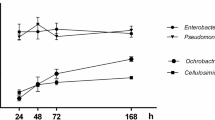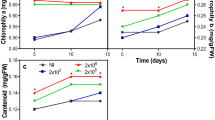Abstract
The use of phosphate solubilizing plant growth-promoting microorganisms as inoculants assists in the hydrolysis of insoluble forms of phosphorus leading to increased plant growth. Pseudomonas putida PCI2 was evaluated for phosphatase activity and solubilization of AlPO4 and FePO4. The effect of different incubation temperatures, concentrations of NaCl and different pH on growth of PCI2 and P solubilization was studied. PCI2 proved to be positive for phosphatase activity, solubilized AlPO4 and hydrolyzed Ca3(PO4)2 even in medium with 5 % NaCl. In addition, PCI2 produced 45 % units of siderophores. The production of IAA by PCI2 was stimulated in vitro by the addition of different concentrations of L-tryptophan to the culture medium. Assays with tomato seedlings showed that the length of the root was reduced as the concentration of IAA increased. On the other hand, inoculation with PCI2 caused a clear growth-promoting effect on shoot growth in the presence of L-tryptophan. P. putida PCI2 is adapted to different environmental conditions and has potential to be developed and used as an inoculant for increasing the growth of tomato plants.






Similar content being viewed by others
References
Adesemoye AO, Torbert HA, Kloepper JW (2009) Plant growth-promoting rhizobacteria allow reduced application rates of chemical fertilizers. Microb Ecol 58:921–929
Ahmadzadeh M, Tehrani AS (2009) Evaluation of fluorescent pseudomonads for plant growth promotion, antifungal activity against Rhizoctonia solani on common bean, and biocontrol potential. Biol Control 48:101–107
Arshad M, Frankenberger WT (1998) Plant growth-regulating substances in the rhizosphere: microbial production and functions. Adv Agron 62:45–151
Asghar HN, Zahir ZA, Arshad M, Khalig A (2002) Relationship between in vitro production of auxins by rhizobacteria and their growth-promoting activities in Brassica juncea L. Biol Fertil Soils 35:231–237
Ayala S, Prakasa Rao EVS (2002) Perspectives of soil fertility management with a focus on fertilizer use for crop productivity. Curr Sci India 7:797–807
Babana AH, Antoun H (2006) Effect of Tilemsi phosphate rock-solubilizing microorganisms on phosphorus uptake and yield of field-grown wheat (Triticum aestivum L.) in Mali. Plant Soil 287:51–58
Banerjee S, Palit R, Sengupta C, Standing D (2010) Stress induced phosphate solubilization by Arthrobacter sp. and Bacillus sp. isolated from tomato rhizosphere. Aust J Crop Sci 4:378–383
Bashan Y, de-Bashan LE (2005) Fresh-weight measurements of roots provide inaccurate estimates of the effects of plant growth-promoting bacteria on root growth: a critical examination. Soil Biol Biochem 37:1795–1804
Behbahani M (2010) Investigation of biological behavior and colonization ability of Iranian indigenous phosphate solubilizing bacteria. Sci Hortic 124:393–399
Bianco C, Defez R (2011) Soil bacteria support and protect plants against abiotic stresses. In: Shanker A (ed) Abiotic stress in plants, mechanisms and adaptations. Intech, Rijeka, pp 143–170
Canbolat MY, Bilen S, Çakmakçı R, Şahin F, Aydın A (2006) Effect of plant growth-promoting bacteria and soil compaction on barley seedling growth, nutrient uptake, soil properties and rhizosphere microflora. Biol Fertil Soils 42:350–357
Cassán F, Perrig D, Sgroy V, Masciarelli O, Penna C, Luna V (2009) Azospirillum brasilense Az39 and Bradyrhizobium japonicum E109 promote seed germination and early seedling growth, independently or co-inoculated in maize (Zea mays L.) and soybean (Glycine max L.). Eur J Soil Biol 45:28–35
Chen C, Bauske EM, Musson G, Rodriguez-Kabaña R, Kloepper JW (1994) Biological control of Fusarium on cotton by use of endophytic bacteria. Biol Control 5:83–91
Corvo Dolcet S (2003) Zonas de producción del cultivo del tomate en la Argentina. http://www.seedquest.com/News/releases/2005/pdf/13528.pdf. Accessed 9 Oct 2013
Crowley DE (2006) Microbial siderophores in the plant rhizosphere. In: Barton LL, Abadia J (eds) Iron, nutrition in plants and rhizosphere microorganisms. Springer, Riverside, pp 169–198
Datta M, Palit R, Sengupta C, Kumar PM, Banerjee S (2011) Plant growth promoting rhizobacteria enhance growth and yield of chilli (Capsicum annuum L.) under field conditions. Aust J Crop Sci 5:531–536
Dey R, Pal KK, Bhatt DM, Chauhan SM (2004) Growth promotion and yield enhancement of peanut (Arachis hypogaea L.) by application of plant growth promoting rhizobacteria. Microbiol Res 159:371–394
Figueiredo MVB, Burity HA, Martinez CR, Chanway CP (2008) Alleviation of water stress effects in common bean (Phaseolus vulgaris L.) by co-inoculation Paenibacillus x Rhizobium tropici. Appl Soil Ecol 40:182–188
Grattan SR, Grieve CM (1999) Salinity-mineral nutrient relations in horticultural crops. Sci Hortic 78:127–157
Gravel V, Antoun H, Tweddell RJ (2007) Growth stimulation and fruit yield improvement of greenhouse tomato plants by inoculation with Pseudomonas putida or Trichoderma atroviride: Possible role of indole acetic acid (IAA). Soil Biol Biochem 39:1968–1977
Gray EJ, Smith DL (2005) Intracellular and extracellular PGPR: commonalities and distinctions in the plant–bacterium signaling processes. Soil Biol Biochem 37:395–412
Hameedaa B, Harinib G, Rupelab OP, Wanib SP, Reddy G (2008) Growth promotion of maize by phosphate-solubilizing bacteria isolated from composts and macrofauna. Microbiol Res 163:234–242
Kamilova F, Kravchenko LV, Shaposhnikov AI, Azarova T, Makarova N, Lugtenberg B (2006) Organic acids, sugars, and L-tryptophan in exudates of vegetables growing on stonewool and their effects on activities of rhizosphere bacteria. Mol Plant Microbe Interact 19:250–256
Kawaguchi M, Syono K (1996) The excessive production of indole-3-acetic acid and its significance in studies of the biosynthesis of this regulator of plant growth and development. Plant Cell Physiol 37:1043–1048
Kim KY, Jordan D, McDonald GA (1998) Effect of phosphate solubilizing bacteria and vesicular–arbuscular mycorrhizae on tomato growth and soil microbial activity. Biol Fertil Soils 26:79–87
King EO, Ward MK, Ranney DE (1954) Two simple media for the demonstration of pyocyanin and fluorescin. J Lab Clin Med 44:301–307
Kloepper JW, Schroth MN (1978) Plant growth-promoting rhizobacteria on radishes. In: Station de pathologie végétale et phytobactériologie (ed) Proceedings of the fourth international conference on plant pathogenic bacteria, vol II. Gilbert Clary, Tours, pp 879–882
Kumar S, Pandey P, Maheshwari DK (2009) Reduction in dose of chemical fertilizers and growth enhancement of sesame (Sesamum indicum L.) with application of rhizospheric competent Pseudomonas aeruginosa LES4. Eur J Soil Biol 45:334–340
Kumar A, Kumar A, Devi S, Pati S, Payal C, Negi S (2012) Isolation, screening and characterization of bacteria from rhizospheric soils for different plant growth promotion (PGP) activities: an in vitro study. Recent Res Sci Technol 4:1–5
Malboobi MA, Owlia P, Behbahani M, Sarokhani E, Moradi S, Yakhchali B, Deljou A, Morabbi Heravi K (2009) Solubilization of organic and inorganic phosphates by three highly efficient soil bacterial isolates. World J Microbiol Biotechnol 25:1471–1477
Mercado-Blanco J, Bakker AHM (2007) Interactions between plants and beneficial Pseudomonas spp.: exploiting bacterial traits for crop protection. Antonie Van Leeuwenhoek 92:367–389
Mundra S, Arora R, Stobdan T (2011) Solubilization of insoluble inorganic phosphates by a novel temperature-, pH-, and salt-tolerant yeast, Rhodotorula sp. PS4, isolated from seabuckthorn rhizosphere, growing in cold desert of Ladakh, India. World J Microbiol Biotechnol 27:2387–2396
Naika S, van Lidt de Jeude J, de Goffau M, Hilmi M, van Dam B (2005) Cultivation of tomato: production, processing and marketing. Agromisa Foundation and CTA, Wageningen, Netherlands. http://journeytoforever.org/farm_library/AD17.pdf. Accessed 9 Oct 2013
Nautiyal CS, Bhadauria S, Kumar P, Lal H, Mondal R, Verma D (2000) Stress induced phosphate solubilization in bacteria isolated from alkaline soils. FEMS Microbiol Lett 182:291–296
Okon Y, Labandera-Gonzalez CA (1994) Agronomic applications of Azospirillum: An evaluation of 20 years worldwide field inoculation. Soil Biol Biochem 12:1591–1601
Orhan E, Esitken A, Ercisli S, Turan M, Sahin F (2006) Effects of plant growth promoting rhizobacteria (PGPR) on yield, growth and nutrient contents in organically growing raspberry. Sci Hortic 111:38–43
Pastor NA, Reynoso MM, Tonelli ML, Masciarelli O, Rosas SB, Rovera M (2010) Potential biological control Pseudomonas sp. PCI2 against damping-off of tomato caused by Sclerotium rolfsii. J Plant Pathol 92:737–745
Pastor NA, Carlier E, Andrés J, Rosas SB, Rovera M (2012) Characterization of rhizosphere bacteria for control of phytopathogenic fungi of tomato. J Environ Manag 95:332–337
Ramamoorthy V, Raguchander T, Samiyappan R (2002) Enhancing resistance of tomato and hot pepper to Pythium diseases by seed treatment with fluorescent pseudomonads. Eur J Plant Pathol 108:429–441
Richardson AE, Barea JM, McNeill AM, Prigent-Combaret C (2009) Acquisition of phosphorus and nitrogen in the rhizosphere and plant growth promotion by microorganisms. Plant Soil 321:305–333
Rodriguez H, Fraga R (1999) Phosphate solubilizing bacteria and their role in plant growth promotion. Biotechnol Adv 17:319–339
Rosas SB, Andrés JA, Rovera M, Correa NS (2006) Phosphate-solubilizing Pseudomonas putida can influence the rhizobia–legume simbiosis. Soil Biol Biochem 38:3502–3505
Rosas SB, Avanzini G, Carlier E, Pasluosta C, Pastor N, Rovera M (2009) Root colonization and growth promotion of wheat and maize by Pseudomonas aurantiaca SR1. Soil Biol Biochem 41:1802–1806
Saharan BS, Nehra V (2011) Plant growth promoting rhizobacteria: a critical review. Life Sci Med Res 21:1–30
Sarwar M, Frankenberger WT (1994) Influence of L-tryptophan and auxins applied to the rhizosphere on the vegetative growth of Zea mays L. Plant Soil 160:97–104
Sayyed RZ, Badgujar MD, Sonawane HM, Mhaske MM, Chincholkar SB (2005) Production of microbial iron chelators (siderophores) by fluorescent Pseudomonads. Indian J Biotechnol 4:484–490
Sharma A, Johri BN (2003) Combat of iron-deprivation through a plant growth promoting fluorescent Pseudomonas strain GRP3A in mung bean (Vigna radiata L. Wilzeck). Microbiol Res 158:77–81
Son HJ, Park GT, Cha MS, Heo MS (2006) Solubilization of insoluble inorganic phosphates by a novel salt- and pH-tolerant Pantoea agglomerans R-42 isolated from soybean rhizosphere. Bioresour Technol 97:204–210
Tanimoto E (2005) Regulation of root growth by plant hormones—roles for auxin and gibberellin. Crit Rev Plant Sci 24:249–265
Van Loon LC (2007) Plant responses to plant growth-promoting rhizobacteria. Eur J Plant Pathol 119:243–254
Vassilev N, Vassileva M, Nikolaeva I (2006) Simultaneous P-solubilizing and biocontrol activity of microorganisms: potential and future trends. Appl Microbiol Biotechnol 71:137–144
Vassilev N, Eichler-Löbermann B, Vassileva M (2012) Stress-tolerant P-solubilizing microorganisms. Appl Microbiol Biotechnol 95:851–859
Vessey JK (2003) Plant growth-promoting rhizobacteria as biofertilizers. Plant Soil 255:571–586
Yanes ML, De La Fuente L, Altier N, Arias A (2012) Characterization of native fluorescent Pseudomonas isolates associated with alfalfa roots in Uruguayan agroecosystems. Biol Control 63:287–295
Acknowledgments
This work was supported by grants from Secretaría de Ciencia y Técnica de la Universidad Nacional de Río Cuarto (Córdoba, Argentina), Agencia Nacional de Promoción Científica y Tecnológica (Secretaría de Ciencia y Técnica de la Nación) and Consejo Nacional de Investigaciones Científicas y Técnicas (CONICET, Argentina).
Author information
Authors and Affiliations
Corresponding author
Rights and permissions
About this article
Cite this article
Pastor, N., Rosas, S., Luna, V. et al. Inoculation with Pseudomonas putida PCI2, a phosphate solubilizing rhizobacterium, stimulates the growth of tomato plants. Symbiosis 62, 157–167 (2014). https://doi.org/10.1007/s13199-014-0281-3
Received:
Accepted:
Published:
Issue Date:
DOI: https://doi.org/10.1007/s13199-014-0281-3




